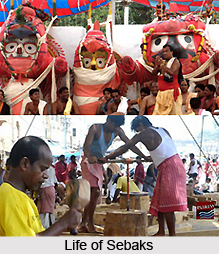 Social life of the sebakas is quite traditional. The sebakas of the Jagannath Temple of Puri live close to the temple in large concentration. In fact, the streets occupied by the sebakas start from the temple occupying the central place in the sacred geography of Puri and then run in different directions. The houses are constructed on elevated platforms made of stone and are in most cases without windows. Small opening are provided in the walls which let some light into the rooms.
Social life of the sebakas is quite traditional. The sebakas of the Jagannath Temple of Puri live close to the temple in large concentration. In fact, the streets occupied by the sebakas start from the temple occupying the central place in the sacred geography of Puri and then run in different directions. The houses are constructed on elevated platforms made of stone and are in most cases without windows. Small opening are provided in the walls which let some light into the rooms.
It is said that after a sebaka has studied up to the primary standard he enters into temple service. The sebakas are much averse to western medicine and allopathic treatment for their illness. They have strong faith on Ayurvedic medicine and spells and divinations. They regularly practise gymnastic performances and physical exercises at the recreational centres called Jegaghar and take milk, ghee and cheese in sufficient quantity.
The women of the sebaka family rarely come out of their houses. Most of them are in the habit of wearing traditional ornaments. In the lives of the Sebaka there is hardly any touch of modernity. As far as the dresses of the sebakas are concerned they wear locally woven silken clothes which are generally woven and available at Berhampur. They do not wear shoes. They use necklace made of tulsi shrub and gold. They are fond of music and practise child marriage. Endogamy is the rule and therefore marriage relationship is found among near relatives.
In every sebaka house the front door has a painting of Lord Ganesha and Bhairab which are worshipped everyday by the sebakas. They observe all the festivals which are observed in the temple. In addition they worship I`micha Devta (five gods)-Narayan, Ganesh, Rudra, Ambika and Bhaskar.
The young girls of the sebaka community observe a ritual called Neta which is held on the 8th day of the bright half of Aswin. On this occasion they are dressed in the most traditional ornaments and worship Durga at the tank of Markanda, one of the Panch Tirthas five places of pilgrimage located in Puri town.
They worship Lokanath (Shiva), another important sacred centre located in Puri town. They hold Lokanath with great reverence and do not dare take oath upon his name. They have no such fear for Lord Jagannath whom they consider as one of their relatives. Though they live along the seashore they rarely visit it, because the sea is the father-in-law of Lord Jagannath and it is not good to visit often a relative`s house.
According to the sebakas of Jagannath Temple, Puri is the holiest pilgrimage of all the places that are present in the country. The sebakas observe certain customs which qualify them to be the sebakas of Lord Jagannath and it is because of this type of life-style that people look upon them as Tirth gurus.





















